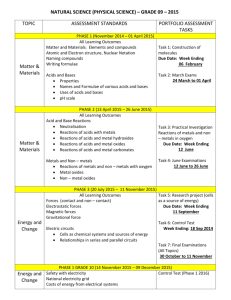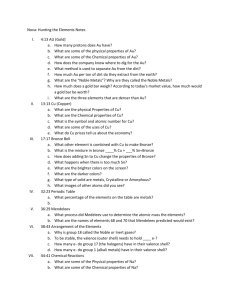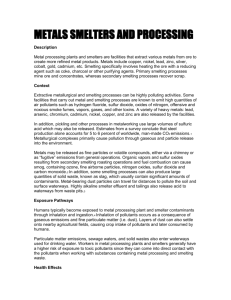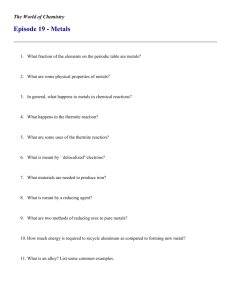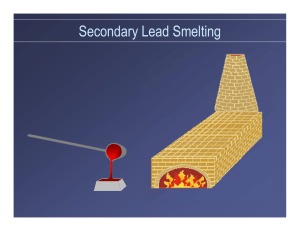Unit 3 Ch. 9 - Single Replacement Reactions
advertisement
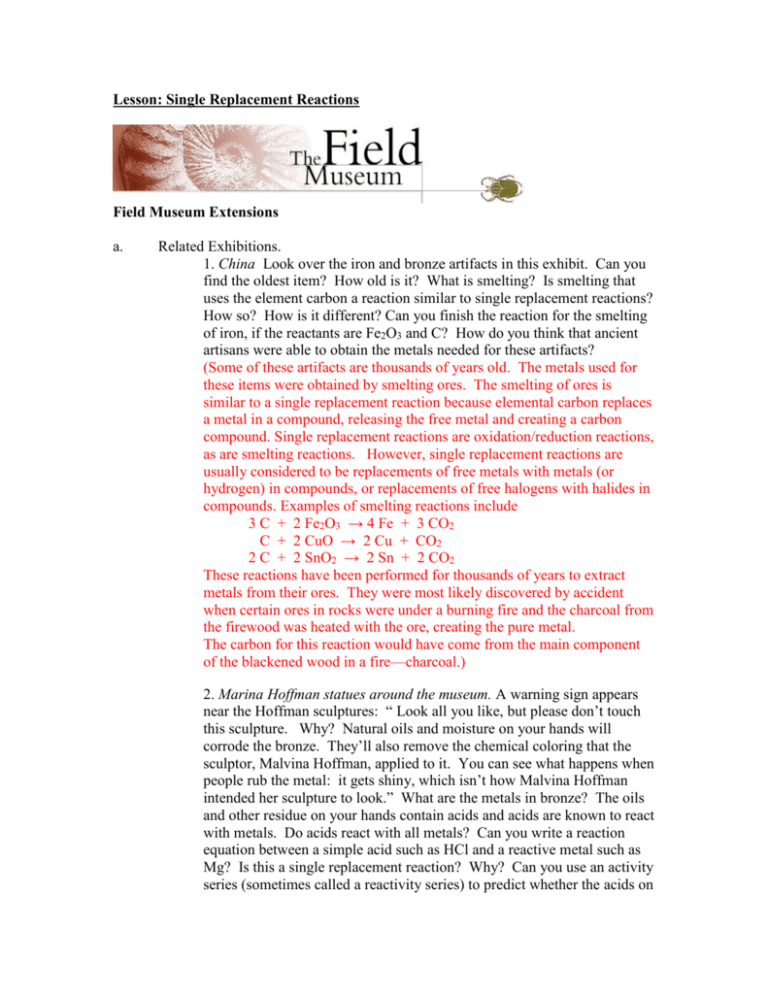
Lesson: Single Replacement Reactions Field Museum Extensions a. Related Exhibitions. 1. China Look over the iron and bronze artifacts in this exhibit. Can you find the oldest item? How old is it? What is smelting? Is smelting that uses the element carbon a reaction similar to single replacement reactions? How so? How is it different? Can you finish the reaction for the smelting of iron, if the reactants are Fe2O3 and C? How do you think that ancient artisans were able to obtain the metals needed for these artifacts? (Some of these artifacts are thousands of years old. The metals used for these items were obtained by smelting ores. The smelting of ores is similar to a single replacement reaction because elemental carbon replaces a metal in a compound, releasing the free metal and creating a carbon compound. Single replacement reactions are oxidation/reduction reactions, as are smelting reactions. However, single replacement reactions are usually considered to be replacements of free metals with metals (or hydrogen) in compounds, or replacements of free halogens with halides in compounds. Examples of smelting reactions include 3 C + 2 Fe2O3 → 4 Fe + 3 CO2 C + 2 CuO → 2 Cu + CO2 2 C + 2 SnO2 → 2 Sn + 2 CO2 These reactions have been performed for thousands of years to extract metals from their ores. They were most likely discovered by accident when certain ores in rocks were under a burning fire and the charcoal from the firewood was heated with the ore, creating the pure metal. The carbon for this reaction would have come from the main component of the blackened wood in a fire—charcoal.) 2. Marina Hoffman statues around the museum. A warning sign appears near the Hoffman sculptures: “ Look all you like, but please don’t touch this sculpture. Why? Natural oils and moisture on your hands will corrode the bronze. They’ll also remove the chemical coloring that the sculptor, Malvina Hoffman, applied to it. You can see what happens when people rub the metal: it gets shiny, which isn’t how Malvina Hoffman intended her sculpture to look.” What are the metals in bronze? The oils and other residue on your hands contain acids and acids are known to react with metals. Do acids react with all metals? Can you write a reaction equation between a simple acid such as HCl and a reactive metal such as Mg? Is this a single replacement reaction? Why? Can you use an activity series (sometimes called a reactivity series) to predict whether the acids on your skin are corroding the metals in bronze? What other reactions might be occuring that would corrode the bronze? (Bronze is an alloy containing Cu and Sn. Students should see from their positions on an activity series relative to H2 that these metals will not react with an acid in a single replacement reaction. Mg will react, as students should predict from its position on the activity series: Mg (s) + 2 HCl (aq) MgCl2 (aq) + H2 (g) This is a single replacement reaction with the free element Mg replacing a cation (H+) in a compound, freeing hydrogen and creating a compound with Mg+2. Copper reacts with oxygen and water in the air, and this oxidation/reduction reaction is catalyzed by the aqueous salts in skin moisture and the fatty acids in skin oil. (These compounds create an electrically conductive solution that facilitates the transfer of electrons in the redox reaction.) The Cu is oxidized to CuO and patina, which is a mixture of Cu(OH)2 and CuCO3 (and probably some Cu(C2H3O2)2 is created also). Further contact of these compounds with the acids in skin moisture promotes a reaction that creates soluble copper compounds. Also, these compounds can be rubbed off of the surface of the metal. Tin reacts in a similar fashion. Gradually, the bronze is eroded by the human contact. b. Harris Educational Loan Center. 1. Iron Blast Furnace Exhibit Case (along with “Iron—Ores Of” exhibit case and “Ores of Common Metals” exhibit case. “Find out what it takes to extract metal for its ore using a smelting furnace. A cross section of a model Iron Blast Furnace, complete with an ore-filled tower, a blasting furnace and stove, demonstrate the hot, complicated process of smelting.” Discuss the replacement of iron in a compound with carbon in a redox reaction similar to single replacement reactions. Write the smelting reactions for certain metals. (This exhibit case activity is matched with the China exhibition activity.) c. Field Museum Science/Website Resources. 1. Library Photo Archives—Erosion damage to Caryatid statue on the outside of the Field Museum (http://www.fieldmuseum.org/research_collections/library/library_sites/ph oto_archives/g2closeup6.htm). Acids react with a variety of materials, including the main mineral in limestone, CaCO3. The reaction of nitric acid (one of the acids in acid rain) with CaCO3 looks like a double replacement reaction: 2 HNO3 (aq) + CaCO3 (aq) → H2CO3 (aq) + Ca(NO3)2 (aq). The reaction of acids with some metals is a single replacement reaction. Write the reaction of nitric acid with Fe or Zn (common reactive metals in building materials). What happens to the building material in this type of reaction? (Example: 2 HNO3 (aq) + Zn → Zn(NO3)2 (aq) + H2 (g) The zinc becomes part of a soluble compound and will be eroded.)
